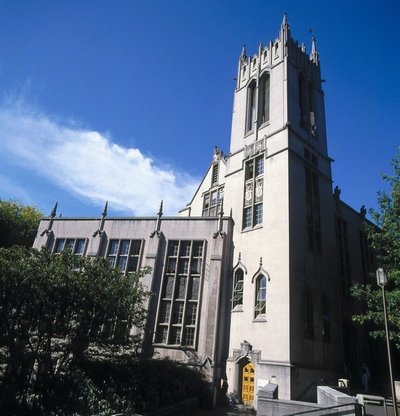February 28, 2008
Bells will be ringing in Gerberding tower this spring
Construction is beginning this week to make way for a set of eight bells to be installed in the tower of Gerberding Hall. The bells are a gift from an anonymous donor, the culmination of a longtime project that was coordinated by Rebecca Woodgate, a UW oceanographer and enthusiastic change ringer.
This peal of bells will be the first change ringing installation in the mainland United States west of Texas. Although there are over 5,000 change ringing towers in the United Kingdom, there are only 42 in the U.S., the closest being in Chicago and Abilene. However, the world of ringing is international. The closest ringing groups are in Vancouver and Victoria, British Columbia.
According to Woodgate, change ringing — the practice of ringing a set of tuned bells in continually varying order — is distinctive in that a team of ringers (one person per bell) ring the bells (here eight bells tuned in a major octave) in patterns, rather than tunes. A set of eight bells allows for over 40,000 different orderings of the bells. Each bell is mounted on a full wheel and, on the pull of a rope, swings full circle, from mouth-up to mouth-up. Thus, different weights of bells (each a different note) can be rung at the same speed. An internal, free-swinging clapper strikes the bell as it swings and the swinging slightly modulates the sound, making the bells acoustically interesting.
“Change ringing is a challenging, inclusive, intellectual and physical activity involving non-competitive teamwork, with opportunities for lifelong learning and worldwide experience,” Woodgate said.
Traditionally, she said, ringers are a diverse group of widely varying backgrounds and ages. The UW bells will be rung by a trained “band” of volunteers, augmented by national and international ringing visitors. The University will offer training courses for those interested.
“We look forward to creating a welcoming band, open both to UW students, staff and faculty, and also to those from the Seattle (and surrounding) community,” Woodgate said.
According to Woodgate, change ringing originated in the UK in the 17th century, and is now practiced globally, with famous bells in towers around the world. This includes rings in secular towers (e.g., the Post Office Tower in Washington, D.C.; the Swan Bells in Perth, Australia), universities (including Oxford, UK, and the University of Chicago), and also religious buildings (e.g. the National Cathedral Washington, D.C.; and St. Paul’s in London).
Change ringing bells are traditionally made of a bronze alloy — 77 percent copper, 23 percent tin. The UW bells have been cast by the world’s largest bell foundry, the Royal Eijsbouts Bellfoundry in the Netherlands, and vary between 200 and 700 lbs. UK bell hangers Taylors Eayre and Smith (founded as Taylors in 1784) have designed the bell installation and will oversee the hanging of the bells.
Local architects Stock & Associates are masterminding the work in Gerberding Tower, which includes the construction of a belfry for the bells, a ringing room below from which the ringers control the bells via ropes and louvers to protect the bells from the weather. Woodgate was supported in her work on the project by other ringers in Vancouver and Seattle, with advice from the UK and the North American Guild of Change Ringers.
The bells at UW will be rung to mark University events (such as convocation and graduation) and public times of celebration or remembrance. They will be maintained through an endowment to the UW’s School of Music.
The bells arrived in Seattle last week, and construction on the tower is being overseen by UW project manager Ivan Turner. The bells will be lifted into the belfry on a date to be announced, probably in late April. A team of ringers is already in training, and the first public ringing of the bells will be announced later.
Anyone interested in learning to ring (or who is already a change ringer) is encouraged to contact Woodgate, 206-221-3268, e-mail: woodgate@apl.washington.edu or rebeccawoodgate@yahoo.com). More details about change ringing are available at the North American Guild of Change Ringers’ Web site www.nagcr.org. Or, for a more literary introduction, read The Nine Tailors, a Dorothy L. Sayers mystery novel.
The support of the director of the School of Music, Robin McCabe, has been essential to the completion of the project. She said of the bells, “It’s a beautiful sound. It’s unlike anything else you hear. It’s so pure. And the tradition behind it is enormously rich.”

